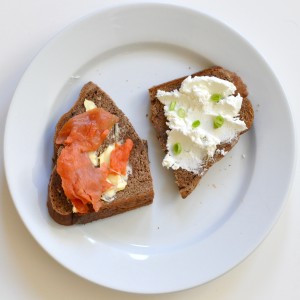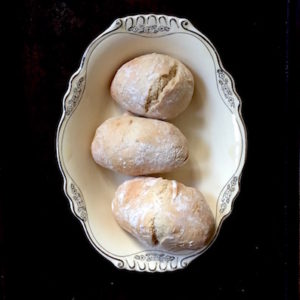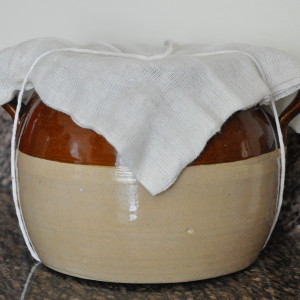Rye Rolls
Pity the humble roll. Out of favor in a wheat-fearing world, the roll joins its fellow carbs in food purgatory, where its crimes are multiple: carbs, calories, and gluten.

The roll’s larger brethren, better known as sliced bread or buns, continue to find some favor as sandwich wrappers. But even when upsized to sandwich status, the roll is often subject to outright dismissal. Remember dining out? (I know, think back.) Once upon a time, bread baskets were de rigeuer. Now your server asks whether your party wants bread or not.

The roll has become the bread version of gelatin molds: consigned to the holiday table, a vintage curiousity.

Were this not bad enough, many of us recall a product sold in cardboard tubes. Torn open, the cardboard revealed a rubbery, puffy product purporting to be fresh bread. Preheat your oven, slice the gelid stuff into pucks, bake.

Not the product. Actual dough.
It is time to rehabilitate the roll’s reputation.

These rye rolls take their inspiration from a recipe in the late, great Margaret Costa’s Four Seasons Cookery Book. Like Jane Grigson, Costa has never been well known in the States. More’s the pity.
These rolls may be baked plain, or you can improve upon them with additions like caraway or fennel seed. Or both. Or other seasonings like cumin and garlic.

They’re also amenable to temperature screw ups; I baked one batch at 375F/190C instead of 425F/220C, and they were fine.

Eat your rye rolls for breakfast, as my husband does, with butter and jam, or park one alongside your dinner plate (or more than one, as the case may be) like I do.

In my typical fashion, I am managing to post this in the midst of a heatwave. Bake in the morning, or wait until the weather cools. Unless you have air conditioning….in which case, may I visit? I’ll wear a mask.
Rye Rolls
inspired by a recipe in Margaret Costa’s Four Seasons Cookery Book
Yield: 12 small rolls, or 8 larger ones
Prep time: the dough takes about 15 minutes to assemble, but needs at least 3 hours rising time. They are best when given an overnight rise in the refrigerator. Baking time is 20 minutes.
Please see the notes for a discussion of alternative flours.
1 generous teaspoon yeast
1/2 cup/120ml warm water
a drop of honey or sugar
1 and 1/2 cups/250g all-purpose or bread flour
1/2 cup/50g rye flour
2 teaspoons salt
1/2 cup/120ml warm milk or half-and-half
Additional flour and water, as needed
vegetable oil, for the bowl
A baking stone is nice but not necessary to bake these rolls. I use ceramic floor tiles bought from a home improvement store. If you follow this route, make sure your tiles have no adhesives on their undersides.
Lightly oil a large, clean bowl for the dough to rise in.
In another large bowl, mix the flours and salt.
Warm your water and add the yeast. The water should be just warm–too hot and the yeast dies. I find nine seconds in the microwave is perfect. Add a drop of honey–I use a quarter teaspoon–or a little sugar, just to get the yeast going.
Let the yeast proof for a few minutes. If it starts to bloom in the water, you’re good to go. If it just sits there, being granular, either your water was too hot or the yeast is dead.
Tip the yeasty water into the flour.
Warm the milk, again, not too hot–and add it to the bowl. Mix with everything with your hands or a wooden spoon until the dough begins coming together.
Empty the entire business onto a clean work surface and knead vigorously for about five minutes. You may need to add more flour and/or water to get a cohesive dough. This depends on the weather and your flour.
The dough may be sticky, which is fine, so long as it isn’t coming off in clumps on your hands or the work surface.
Shape dough into a ball and place in the oiled bowl. Cover with plastic wrap and refrigerate up to 24 hours, or allow to rise for at least two hours at room temperature.
If you’ve refrigerated your dough, take it out and give it 30-40 minutes to warm up before punching it down.
Punch down the dough and give it a few kneads. Using a large knife or bench scraper, cut the dough into 8 large or 12 small rolls. Cover with a clean cloth and allow to rest for an hour.
Preheat your oven to 425F/220C. Put your baking stone in the lower third of the oven, if using. If not, you’ll need a large, heavy baking sheet. If your baking sheets are thin, stack them. This gives a nicer crust.
Place the rolls on the baking stone or baking sheet, and bake for 20 minutes. Rolls are done when lightly browned and sound hollow when tapped.
Place rolls on a cooling rack and wait at least an hour before eating. Bread fresh from the oven is notoriously indigestible, and nobody needs indigestion right now. Or more of it.
The rolls will keep at room temperature for 2 days. After that, freeze them up to two months, reheating in a microwave or low oven.
Notes:
The rolls are best when given an overnight rise in the refrigerator.
The flours are flexible; I baked one batch using a quarter cup/25g barley flour, which I subtracted from the all-purpose flour. Feel free to play.
I’ve baked these using all-purpose and bread flours. Both were good.
A teaspoon of fennel, caraway, and/or cumin seeds may be stirred into the dough. Or try minced garlic, scallion, or other seasonings like sumac.





